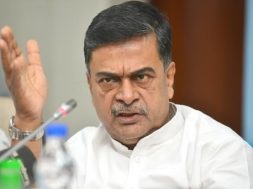
Meeting of Parliamentary Consultative Committee attached to Ministry of Power held – EQ Mag Pro
The Meeting of Parliamentary Consultative Committee attached to the Ministry of Power was held in New Delhi today. Union Minister for Power and MNRE Shri R.K Singh chaired the meeting. Minister of State for Power and Heavy industries Shri Krishan Pal Gurjar was also present in the meeting. Hon’ble Members of Parliament of various political parties took part in the meeting.
The MPs present were Shri Chandra Sekhar Sahu, Lok Sabha, Shri Dinesh Lal Yadav, Lok Sabha, Shri Khagen Murmu, Lok Sabha, Shri Mahabali Singh, Lok Sabha, Shri Pradyut Bordoloi, Lok Sabha, Shri Ritesh Pandey, Lok Sabha, Shri Topon Kumar Gogoi, Lok Sabha, Shri Dhiraj Prasad Sahu, Rajya Sabha, Shri Ramdas Chandrabhanji Tadas, Lok Sabha, Shri Sangeeta Kumari Singh Deo, Lok Sabha and Shri Bashistha Narain Singh, Rajya Sabha. The subject of the meeting was “Development of National Electricity Grid in India – Its Significance”.
In the meeting, it was informed that the transmission system is the backbone of power system. Integrated transmission network allows the power to be generated anywhere. We have One Nation, One Grid, One Frequency, One National Load Dispatch Centre for the country resulting in one market. India’s transmission system is the major integrated grid in the world. At present, the power consumption in the country is 1,400 Billion Units and it will be twice by 2030. Therefore, there is a need to increase the power generation and strengthen the transmission capacity accordingly. Hence, the nation’s transmission will grow rapidly. With the integrated network (General Network Access) it is easier to buy and sell power from anywhere. The government has also opened RE Management centres to cater renewable energy. We have created Central Transmission Utility (CTU) for transparency and level playing field.
A presentation was given by Chairman, CEA to inform the Hon’ble MPs regarding various remedies and measures being undertaken to address Development of National Electricity Grid in India – Its Significance.
The Government of India has initiated multiple initiatives for the Development of National Electricity Grid in India. These initiatives are Evolution and Growth of National Grid, Benefits and Development of National Grid, Planning of National Grid, Significance of National Grid in RE Integration, Policy Reforms to promote RE and Grid Managemnet by Load Despatch Centre.
All 5 regional grids in India were synchronised into the National Grid by December 2013. The remote Leh region was connected to the National Grid in January 2019 through 220 kv Srinagar-Leh Transmission system. The National Grid Transmission system has added transmission line of 1,71,149 ckm since 2014-15 and has added transmission capacity of 6,03,916 MVA since 2014-15. At present, the installed capacity of National Grid is 404 GW and the peak demand met is 216 GW. The National Grid has adopted several technologies such as 1200 kV Ultra High Voltage AC system, Tower designs to reduce RoW, App Based Patrolling, Hot Line Maintenance, Tubular poles for less land regions and Gas Insulated Switchgear (GIS) for maintenance. With the growth in transmission infrastructure and inter-regional transmission capacity, the congestion in transmission network has relieved. Also, it has led to open access transactions with reduction in prices.
The initiatives for integration of Non-fossil Fuel Energy are implementation of Green Energy Corridors, Transmission system for Ultra Mega solar power parks, Transmission system for 66.5 GW renewable energy zones by 2022, establishment of 13 RE Management centres (REMCs) to address variability and uncertainty of RE generation, planning of transmission system for integration of additional 52 GW potential REZ by 2026-27 have been carried out, transmission schemes for another 181.5 GW RES by 2030 have been planned and the same would be taken up for implementation in a progressive manner.
Transmission system for 7 solar parks (6500 MW) in 5 states has been implemented by POWERGRID comprising about 1870 ckm transmission lines and 5 sub-stations with 1,3500 MVA transmission capacity. The policy reforms to promote integration of Renewable Energy are Waiver of inter-State transmission charge on transmission of the electricity generated from solar and wind sources of energy, Bundling of Renewable Energy with Thermal /Hydro Energy under existing PPAs, Green Term-Ahead Market (GTAM), Easier Access to RE Generation Project- General Network Acccess.
The operational areas in grid management by POSOCO are National Open Access Registry (NOAR). NOAR will facilitate the Green Open Access in a transparent way and also the integration with SLDC is in progress.
The recent reform measures taken in transmission sectore are separation of CTU from POWERGRID to bring transparency and make level playing field for all the transmission developers.
The future goals of National Grid are Transmission ahead of generation for seamless integration of RE, OSOWOG: One Sun, One World, One Grid, Facilitate green open Access and Ensure reliability of supply.
Hon’ble Members of Parliament made several suggestions with regard to various initiatives and schemes in the Ministry of Power. Shri Singh closed the meeting thanking the participants for their valuable suggestions.














